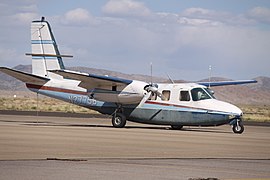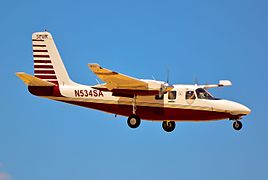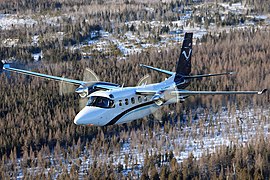Aero Commander 500 family
| Aero Commander twins | |
|---|---|

| |
| 690C Jetprop 1000 | |
| Role | Utilityandbusiness aircraft |
| National origin | United States |
| Manufacturer | Aero Design and Engineering Company Aero Commander Rockwell-Standard Corporation North American Rockwell Rockwell International Gulfstream Aerospace |
| First flight | 23 April 1948 (Model L3085) |
| Introduction | October 1952 |
| Status | Active |
| Produced | 1951–1986 |
| Number built | ~2,902 (1951 piston-engined, 951 turboprops) |
TheAero Commander 500 familyis a series of light-twin piston-engined andturbopropaircraft originally built by the Aero Design and Engineering Company in the late 1940s, renamed theAero Commandercompany in 1950, and later a division ofRockwell Internationalin 1965. Final production occurred under the Gulfstream Aerospace name. The initial production version was the 200 mph (320 km/h; 170 kn), seven-seatAero Commander 520.An improved version, the500S,manufactured after 1967, is known as theShrike Commander.Larger variants are known by numerous model names and designations, ranging up to the 330 mph (530 km/h; 290 kn), 11-seat Model695B/Jetprop 1000Bturboprop.[1] As of recent, the Aerocommander is know as the Twin Commander.
Design and development[edit]

The idea for the Commander light business twin was conceived byTed Smith,a project engineer at theDouglas Aircraft Company.[2]Working part-time after hours throughout 1944, a group ofA-20engineers formed theAero Design and Engineering Companyto design and build the proposed aircraft with a layout similar to their A-20 bomber.[2][3]Originally, the new company was going to build three pre-production aircraft, but as the first aircraft was being built, they decided to build just one prototype.[2]The final configuration was completed in July 1946 and was designated theModel L3805.[2]
RegisteredNX1946,the prototype first flew on 23 April 1948.[2]The L3805 accommodated up to five people and was powered by two Lycoming O-435-Apiston engines.,[1]it was an all-metal high-wingmonoplanewith retractableundercarriageusing components from aVultee BT-13 Valiant.The market segment planned for this aircraft to be sold to small feeder airliner firms and was originally designed to carry seven passengers, but instead found use in the private business aircraft and military market.[4]Walter Beechtest flew the aircraft in 1949 and expressed interest in buying the project, but passed on it, to instead develop theBeechcraft Twin Bonanza.Fairchild Aircraftalso evaluated the prototype at itsHagerstown, Maryland,headquarters.[3]
The prototype flew successfully and the company leased, at no cost, a new 26,000 square feet (2,400 m2) factory atBethanynearOklahoma Cityto build a production version, certified on 30 June 1950. Nearly 10,000 hours of redesign work went into the model, including more powerful Lycoming GO-435-C2 engines, with a combined rating of 520 horsepower (390 kW). The production model was named theCommander 520.The first Commander 520 was rolled out of the new factory in August 1951. Serial number 1 was used as a demonstrator, then sold in October 1952 to the Asahi Shimbun Press Company of Tokyo.[citation needed]
Operational history[edit]
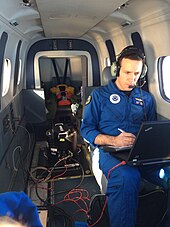
In military service it was initially designated theL-26,though in 1962 this was changed toU-4for theUnited States Air ForceandU-9for theUnited States Army.
Under ownership ofRockwellin the 1960s, World War II pilotR. A. "Bob" Hooverdemonstrated the Shrike Commander 500S for decades in a variety of "managed energy" routines, including single-engine and engine-out aerobatics.[5][6]His Shrike Commander is displayed in the colors of his last sponsor,Evergreen International Aviation,at theSteven F. Udvar-Hazy Centerof theSmithsonianNational Air and Space Museum.Bob Odegaard continued the tradition in 2012, flying a 1975 Shrike 500S in a Bob Hoover tribute routine.[7]
One U-4B became a presidential transport aircraft forDwight D. Eisenhowerbetween 1956 and 1960.[citation needed]This was the smallest "Air Force One",and the first to wear the now-familiar blue-and-white livery.[citation needed]This aircraft is now owned by theCommemorative Air Force.[8]
As of 2004 Shrike Commanders remained in service with theUnited States Customs Service,United States Coast Guard,andUnited States Forest Service.[1]
A single 560F was operated by theBelgian Air Forceas the personal transport of the late kingBaudouin of Belgiumfrom 1961 to 1973.[9]
According to the July 1, 1968,Frontier Airlinessystem timetable, series 500 aircraft were being operated on scheduled passenger flights by Combs Aviation on behalf of Frontier via a contract agreement with service to several smaller communities inMontanaandWyomingat this time.[10][11]
The unpressurized, long-fuselage 680FL was operated as a small package freighter by Combs Freightair in the 1970s and 1980s, and by Suburban Air Freight in the 1980s and 1990s. The aircraft was popular with pilots, because it was extremely "pilot friendly" and with its 380 hp (280 kW) supercharged engines did well in icing meteorological conditions. A number are still operated on contracts for cargo and fire control applications, as their piston engines offer good fuel specifics at low altitudes and longer loiter times.
Wing spar fatigue[edit]
Beginning in June 1991, senior engineers met with FAA officials to discuss concerns over the Aero Commander's main wing spar, which was believed to be susceptible tostress fatigueand subsequent cracking, and was believed to have resulted in a number of fatal crashes.[12]From approximately 1961 to 1993, 24 aircraft crashed when spar failures caused the loss of the wing in flight.[12]35 more spars were found cracked during inspections.[12]
Single-engine safety[edit]
In 1950, when the developers were working to satisfyCivil Aeronautics Authority(CAA) regulations for certification of the 500, they chose a novel method of demonstrating its single-engine safety and performance: they removed one of the two-bladed propellers, secured it in the aft cabin, and flew from Bethany to Washington, D.C., on one engine. There they met with CAA personnel, then replaced the propeller and returned to Oklahoma in the conventional manner. The flight received nationwide coverage in the press.[13][14]
In 1979, theNational Transportation Safety Boardreviewed light-twin engine-failure accidents, involving the 24 most popular model-groups of light twins between 1972 and 1976. They found that thepiston-engined twin-Commanders had averaged slightly over 3.4 engine-failure accidents per hundred-thousand hours, the second worst number of all aircraft under review.[15][16]The most engine failures were suffered by the small-engine versions of thePiper Apache,at 6.9 failures per hundred thousand hours; the third-worst, theBeechcraft Travel Air,averaged 2.9 failures; the average for all models was only 1.6.[15][16]
Countering the statistical evidence, Rockwell demonstration pilotBob Hoover's famous airshow stunt routine, with the Shrike Commander, included a fullaerobaticroutine performed first with both engines, then with one engine out (and thecritical engine,at that), then both engines out, and gliding. Then in his final airshow performance, in a supreme demonstration of conservation of momentum, he did all that, then landed the Shrike Commander dead stick (engines off), coasted the airplane down the runway then from the runway down the taxiway and silently let the craft roll slowly to a full stop right in front of the crowd.[17][18][19]
Theturboproptwin-Commanders—with much more powerful engines (and most with longer bodies, allowing greater rudder leverage, critical for single-engine control[14][20]) – came out on the opposite end of the rankings, with one of thelowestrates of engine-failure accidents of all "light" twins examined, at only 0.4 per hundred-thousand hours.[15]
Variants[edit]
-
Certified from 1954, the seven-seat 560 is powered by two 270–295 hp (201–220 kW)Lycoming GO-480s.
-
From 1955, the 680 has Supercharged 340–380 hp (250–280 kW)Lycoming GSO-480s.
-
From 1958, the lighter 500 is powered by two 250–290 hp (190–220 kW)Lycoming O-540sorContinental IO-470s.
-
From 1963, the stretched 680-FL offered up to eleven seats.
-
It gained two 575 hp (429 kW)AiResearch TPE-331turboprops from the 680-T in 1965.
-
From 1971, the heavier 690 has a larger wing and more powerful 717.5–748 hp (535–558 kW) TPE-331s.
-
From 1979, the final 695 Jetprop 980/1000 is powered by 733–820 hp (547–611 kW) TPE-331s.
| model | name | approved | TC | engines | power | MTOW | ceiling | seats | fuel | built[a] |
|---|---|---|---|---|---|---|---|---|---|---|
| L.3805 | 1 | |||||||||
| 520 | 1952-01-31 | 6A1 | 2×GO-435-C2/C2B | 2× 260 | 5500-5700 | 5 | 145 | 150 | ||
| 560 | 1954-05-28 | 6A1 | 2×GO-480-B/B1C | 2× 270 | 6000 | 7 | 145 | 80 | ||
| more powerful 520 with increased weight and swept tail, revised wing, landing gear, fuselage, vertical tail, and primary control system | ||||||||||
| 560A | 1955-07-01 | 6A1 | 2× GO-480-D/C/G | 2× 275 | 6000 | 7 | 156 | |||
| 560 with longer fuselage, revised engine installation, wing, landing gear, fuel and oil systems | ||||||||||
| 560E | 1957-02-21 | 6A1 | 2× GO-480-C/G | 2× 295 | 6500 | 7 | 223 | 93 | ||
| 560A with Larger wings and greater payload[a],revised engine installation, wing, wheel and brake installation, fuel system with outboard tanks, and landing gear location | ||||||||||
| 560F | 1961-02-08 | 2A4 | 2×IGO-540-B | 2× 350 | 7500 | 7 | 223 | |||
| 680F with unsupercharged engine and reduced gross weight | ||||||||||
| 360 | 2× 180 | 4 | 1 | |||||||
| Lightened 560E[a] | ||||||||||
| 500 | 1958-07-24 | 6A1 | 2×O-540-A2B | 2× 250 | 6000 | 7 | 156 | 101 | ||
| 560E with decreased gross weight, powerplants, and 560A landing gear | ||||||||||
| 500A | Aero Commander | 1960-04-07 | 6A1 | 2×IO-470-M | 2× 260 | 6000 | 7 | 156 | 99 | |
| 500 with new nacelles,[a]fuel injection engine and new landing gear | ||||||||||
| 500B | 1960-07-13 | 6A1 | 2×IO-540-B/E | 2× 290 | 6750 | 7 | 156 | 217 | ||
| 500A with fuel injection[a] | ||||||||||
| 500U | Shrike Commander | 1964-12-11 | 6A1 | 2× IO-540-E | 2× 290 | 6750 | 7 | 156 | 56 | |
| 500B with pointed nose and squared off tail[a] | ||||||||||
| 500S | Shrike Commander | 1968-03-15 | 6A1 | 2× IO-540-E | 2× 290 | 6750 | 7 | 156 | 316 | |
| 500U with minor changes[23][page needed] | ||||||||||
| 680 Super | L-26C → U-4B[b] L-26C → U-9C[c] |
1955-10-14 | 2A4 | 2×GSO-480-A1A6 | 2× 340 | 7000 | 7 | 223 | 254 | |
| supercharged 560A[a] | ||||||||||
| 680E | 1958-06-19 | 2A4 | 2× GSO-480-B1A6 | 2× 340 | 7500 | 7 | 223 | 100 | ||
| 680 with Lightened 560E/560A type undercarriage[a],extended wing and increased maximum weight | ||||||||||
| 720 | AltiCruiser | 1958-12-05 | 2A4 | 2× GSO-480-B1A6 | 2× 340 | 7500 | 6 | 223 | 13 | |
| Pressurized680-E, structural modifications to the fuselage, extended wing and increased maximum weight | ||||||||||
| 680F | 1960-08-23 | 2A4 | 2×IGSO-540-B | 2× 380 | 8000 | 7 | 223 | 126 | ||
| 680E with fuel injection engine, new nacelles, new main gear and increased maximum weight | ||||||||||
| 680FP | 2× 380 | 223 | 26 | |||||||
| Pressurized 680F[a] | ||||||||||
| 680FL | Grand Commander | 1963-05-24 | 2A4 | 2× IGSO-540-B | 2× 380 | 7000-8500 | 11 | 223 | 157 | |
| 680F with larger tail, 2 built for the US Army as the RL-26D → RU-9D withSLAR,Courser Commanderafter 1967;[a]stretched | ||||||||||
| 680FL(P) | Grand Commander | 1964-10-08 | 2A4 | 2× IGSO-540-B1A/B1C | 2× 380 | 8500 | 11 | 223 | 37 | |
| pressurized 680FL | ||||||||||
| 680T | Turbo Commander | 1965-09-15 | 2A4 | 2×TPE-331-43 | 2× 575 | 8950 | 25,000 ft | 11 | 286.5 | 56 |
| 680FL/P turboprop[a] | ||||||||||
| 680V | Turbo Commander | 1967-06-13 | 2A4 | 2× TPE-331-43 | 2× 575 | 9400 | 25,000 ft | 11 | 286.5 | 36 |
| 680T with slightly improved cargo capacity[a] | ||||||||||
| 680W | Turbo II Commander | 1968-02-05 | 2A4 | 2× TPE-331-43BL | 2× 575 | 9400 | 25,000 ft | 11 | 286.5 | 46 |
| 680V with pointed nose. squared off fin, one panoramic and two small cabin windows and weather radar[a] | ||||||||||
| 681 | Hawk Commander | 1969-03-20 | 2A4 | 2× TPE-331-43BL | 2× 575 | 9400 | 25,000 ft | 11 | 286.5 | 43 |
| 680W with improved pressurisation, air conditioning system and nose[a] | ||||||||||
| 681B | Turbo Commander | 25,000 ft | 29 | |||||||
| Marketing designation for economy version of the 681[a] | ||||||||||
| 685 | Commander | 1971-09-17 | 2A4 | 2×GTSIO-520-F/K | 2× 435 | 9000 | 25,000 ft | 9 | 256-322 | 66 |
| 690 powered by piston engines[a] | ||||||||||
| 690 | Commander 690 | 1971-07-19 | 2A4 | 2× TPE-331-5 | 2× 717.5 | 10250 | 25,000 ft | 11 | 384 | 79 |
| 681 with new wing centre section and engines moved further outboard[a] | ||||||||||
| 690A | Commander 690A | 1973-04-25 | 2A4 | 2× TPE-331-5 | 2× 717.5 | 10250 | 31,000 ft | 11 | 384 | 245 |
| 690 with changed flightdeck layout and increased pressurisation[a] | ||||||||||
| 690B | Commander 690B | 1976-10-05 | 2A4 | 2× TPE-331-5 | 2× 717.5 | 10325 | 31,000 ft | 10 | 384 | 217 |
| 690A with improved soundproofing and internal lavatory[a] | ||||||||||
| 690C | Jetprop 840 | 1979-09-07 | 2A4 | 2× TPE-331-5 | 2× 717.5 | 10325 | 31,000 ft | 11 | 384 | 136 |
| 690B with increased wingspan, wet wing fuel tanks and winglets[a] | ||||||||||
| 690D | Jetprop 900 | 1981-12-02 | 2A4 | 2× TPE 331-5 | 2× 748 | 10700 | 31,000 ft | 11 | 425-474 | 42 |
| 690C with internal rear cabin extension, improved pressurisation and five square cabin windows[a] | ||||||||||
| 695 | Jetprop 980 | 1979-11-01 | 2A4 | 2× TPE-331-10 | 2× 733 | 10325 | 31,000 ft | 11 | 425-474 | 84 |
| more powerful 690C[a] | ||||||||||
| 695A | Jetprop 1000 | 1981-04-30 | 2A4 | 2× TPE-331-10 | 2× 820 | 11200 | 35,000 ft | 11 | 474 | 101 |
| more powerful 690D with higher takeoff weight, built for theNOAA[a] | ||||||||||
| 695B | Jetprop 1000B | 1984-02-15 | 2A4 | 2×TPE-331-10 | 2× 820 | 11750 | 35,000 ft | 11 | 474 | 6 |
| 695A with minor changes[a] | ||||||||||
Operators[edit]


Government operators[edit]
Military operators[edit]
- Algerian Air Force– 1 x 680E survey aircraft in 1986[26]
- Angolan Air Force– 1 x 690A VIP aircraft in 1986[27]
- Argentine Air Force– 1 x 500B, 27 x 500U and 1 x 680[28]
- Argentine Army Aviation– 680V, 690A[29]
- Royal Bahamas Defence Force– 500S (no longer operated)[30]
- Benin Air Force– 1 x 500B[31]
- Bolivian Air Force– 1 x 690 in 1986[32]
- Burkina Faso Air Force– 1 x 500B in 1986[33]
- Cuban Air Force– 1 × 560 acquired in late 1956.[37]
- Hellenic Army– 2 x 680FL[39]
- Indonesian Army Aviation Command– 2 x 680FL[42]
- Islamic Republic of Iran Air Force– 3 x 681B[43]
- Islamic Republic of Iran Army Aviation– 3 x 690, 2 x 690A[44]
- Islamic Republic of Iran Navy Aviation– 2 x 500S, 2 x 690, 6 x 690A[45]
- Ivory Coast Air Force– 1 x 500B[46]
- Kenya Air Force– 1 x 680FP (no longer operated)[47]
- Royal Lao Air Force– 1 x 560 (no longer operated)[48]
- Republic of Korea Air Force– 3 x 520, 2 x 560F[49]
- Mexican Air Force– 20 x 500S[50]
- Niger Air Force– 1 x 500B[52]
- Pakistan Air Force– 1 x 680E (with radar nose), 1 x 680F[53]
- Pakistan Army Aviation– 1 x 690B[54]
- United States Air Forceas the L-26 and U-4[58]
- United States Armyas the L-26 and U-9[58]
Civil operators[edit]
- Talofa Airways[59]
- United States Central Air Southwest
Notable accidents[edit]
- On 19 June 1964 SenatorTed Kennedywas a passenger in an Aero Commander 680 airplane flying in bad weather from Washington, D.C., to Massachusetts. It crashed into an apple orchard in thewestern Massachusettstown ofSouthamptonon thefinal approachto theBarnes Municipal AirportnearWestfield.[60][61]The pilot and Edward Moss, one of Kennedy's aides, were killed.[62]Kennedy suffered a severe back injury, apunctured lung,broken ribs and internal bleeding.[63]
- World War II hero and actorAudie Murphydied in an Aero Commander 680crashwhile flying as a passenger on 28 May 1971. The aircraft was flying in bad weather at night and was on approach to Roanoke, Virginia when it flew into the side of Brush Mountain outside Blacksburg, Virginia, West of Roanoke. Four others and the pilot were also killed.[64]
- On 11 August 2002 photographerGalen Rowell,his wife Barbara Cushman Rowell, pilot Tom Reid and Reid's friend Carol McAffee were killed in an Aero Commander 690 crash nearEastern Sierra Regional AirportinBishop, California.[65]
Specifications (Rockwell Aero Commander 500S)[edit]
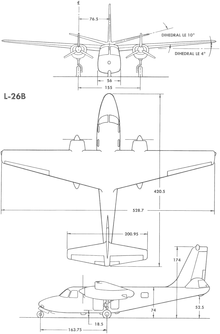
Data fromJane's all the world's aircraft 1976–77.[66]
General characteristics
- Crew:Two
- Capacity:four passengers
- Length:36 ft 9.75 in (11.22 m)
- Wingspan:49 ft 0.5 in (14.95 m)
- Height:14 ft 6 in (4.42 m)
- Wing area:255 sq ft (23.69 m2)
- Aspect ratio:9.45:1
- Airfoil:NACA 23012 modified
- Empty weight:4,635 lb (2,102 kg)
- Max takeoff weight:6,750 lb (3,062 kg)
- Powerplant:2 ×Lycoming IO-540-E1B5 air-cooledflat-sixpiston engines,290 hp (216 kW) each
Performance
- Maximum speed:215 mph (346 km/h, 187 kn) at sea level (TAS)
- Cruise speed:203 mph (326 km/h, 176 kn) at 9,000 ft (2,750 m), 75% power, TAS
- Stall speed:68 mph (109 km/h, 59 kn) flaps and landing gear down,CAS
- Minimum control speed:75 mph (121 km/h, 65 kn)
- Range:1,078 mi (1,735 km, 936 nmi)
- Service ceiling:19,400 ft (5,913 m)
- Rate of climb:1,340 ft/min (6.8 m/s)
See also[edit]
References[edit]
Notes[edit]
- ^abc"Rockwell U-9A Aero Commander".March Field Air Museum.Archived fromthe originalon 18 August 2007.Retrieved1 August2007.
- ^abcdeCollman, B.J. (May–June 1973). "The Aero Commander Twins".Air-Britain Digest.15(3): 79–86.
- ^abWilliams, Nicholis M (Spring 1990). "The Aero Commander 520".AAHS Journal.
- ^"What's New in Aviation: Feederliner Makes Debut".Popular Science.Vol. 153, no. 2. August 1948. p. 90.
- ^"Shrike Commander".Flying.July 1972. pp. 72–73, 76.
- ^Collins, Richard L. (January 1999). "Grand Renaissance: The rebirth of the tough bird".Flying.Vol. 126, no. 1. pp. 80–83.
- ^"missing".Sport Aviation:30. June 2011.
- ^"President Eisenhower's Twin-Engine Air Force One".Ike's Bird.Archived fromthe originalon 27 October 2020.
- ^"Aerocommander 560f".Archived fromthe originalon 17 February 2010.
- ^"fl6807-1 JPG file".
- ^"fl6807-4 JPG file".
- ^abcSwift, S. J. (1 May 1995),The Aero Commander chronicle(PDF),Civil Aviation Safety Authority,retrieved1 August2007
- ^Harris, Richard."The Aero Commander Line – A short history".Archivedfrom the original on 13 July 2011.Retrieved13 August2011.
- ^abSmith, Thomas Motley (1981).Multiengine Airplane Rating: A Guide to the FAA Oral and Flight Tests.Pan American Navigation Service.ISBN0-87219-003-X.OCLC7958067.
- ^abc"Special Study:" Light Twin-Engine Aircraft Accidents Following Engine Failures, 1972–1976 NTSB-AAS-79-2 "(PDF).Washington, D.C.: National Transportation Safety Board. 1979.Retrieved16 May2017.
- ^abIbold, Ken, ed. (2001).Aviation Consumer's Used Aircraft Guide.Vol. 2 (9 ed.). Greenwich, Connecticut: Belvoir Publications.
- ^Cochrane, Dorothy (20 February 2014)."Robert A_" Bob "Hoover, The Greatest Stick and Rudder Man, is Honored in Hollywood".Smithsonian National Air and Space Museum.Washington, D.C.Retrieved16 May2017.
- ^"Bob Hoover flies west".GeneralAviationNews.com.25 October 2016.Retrieved29 August2020.
- ^"Bob Hoover's Last Air Show"– via YouTube.
- ^"Checkout in a Multiengine Airplane".Flight Training Handbook Advisory Circular 61-21A.Federal Aviation Administration.
- ^"Type Certificate data sheet No. 6A1"(PDF).FAA. 25 September 2015.
- ^"Type Certificate data sheet No. 2A4"(PDF).FAA. 25 September 2015.
- ^Simpson 1995
- ^"TxDPS – Aircraft History".dps.texas.gov.Retrieved27 August2018.
- ^Seymour, Paul (28 December 2018)."AERO COMMANDER 560A, P-2001 / 310-73, INDONESIAN POLICE / POLISI".abpic.co.uk.Retrieved1 April2021.
- ^Flight International29 November 1986,p. 32
- ^Flight International29 November 1986,p. 33
- ^Andrade 1982,p. 12
- ^Andrade 1982,p. 13
- ^"Royal Bahamas Defence Force (RBDF) – Air Wing".LA MILITARY.9 April 2016.
- ^Andrade 1982,p. 26
- ^Flight International29 November 1986,p. 37
- ^Flight International29 November 1986,p. 39
- ^"World Air Forces 2022".FlightGlobal.2022.Retrieved17 July2022.
- ^"División de Aviación Asalto Aéreo incorpora nuevo avión Turbo Commander 690D".webinfomil.com.Retrieved19 December2016.
- ^Hagedorn 1993,p. 128
- ^Hagedorn 1993,p. 18
- ^Flight International29 November 1986,p. 49
- ^Andrade 1982,p. 94
- ^Hagedorn 1993,p. 55
- ^ab"World Air Forces 2021".FlightGlobal.4 December 2020.Retrieved10 August2021.
- ^Andrade 1982,p. 106
- ^Andrade 1982,p. 107
- ^Andrade 1982,p. 109
- ^Andrade 1982,p. 110
- ^Andrade 1982,p. 126
- ^Andrade 1982,p. 141
- ^"Royal Lao Air Force Aircraft Types".aeroflight.co.uk.Retrieved19 December2016.
- ^Andrade 1982,p. 143
- ^Andrade 1982,p. 156
- ^Hagedorn 1993,p. 42
- ^Andrade 1982,p. 167
- ^Andrade 1982,p. 172
- ^Andrade 1982,p. 173
- ^Hagedorn 1993,p. 120
- ^"World Air Forces 2013"(PDF).Flightglobal Insight. 2013.Retrieved12 March2013.
- ^Flight International29 November 1986,p. 92
- ^abAndrade 1979,p. 134
- ^"When in Samoa, fly with Talofa and its Twin Commanders".Flight Levels Online.21(3). 2016.
- ^"Teddy's Ordeal".Time.26 June 1964. Archived fromthe originalon 4 February 2013.Retrieved23 May2008.
- ^"The Luck of the Kennedys".Check-Six.com. 8 May 2008.Archivedfrom the original on 1 February 2009.Retrieved24 February2009.
- ^"John F. Kennedy Jr. – Timeline: Misfortunes of a Family".CNN. July 1999. Archived fromthe originalon 23 March 2008.Retrieved23 May2008.
- ^Swidey, Neil (16 February 2009)."Chapter 2: The Youngest Brother: Turbulence and tragedies eclipse early triumphs".The Boston Globe.Archivedfrom the original on 22 February 2009.Retrieved24 February2009.
- ^"Biography for Audie Murphy".IMDb.1 August 2007.Retrieved1 August2007.
- ^Delgado, Ray (12 August 2002)."Galen Rowell 1940–2002".San Francisco Chronicle.Hearst Communications Inc.Retrieved27 November2016.
- ^Taylor 1976,pp. 346–347
Bibliography[edit]
- Andrade, John (1979).U.S. Military Aircraft Designations and Serials since 1909.Midland Counties Publications.ISBN0-904597-22-9.
- Andrade, John (1982).Militair 1982.London: Aviation Press Limited.ISBN0-907898-01-7.
- Hagedorn, Daniel P. (1993).Central American and Caribbean Air Forces.Kent, UK: Air-Britain (Historians).ISBN978-0851302102.
- Hatch, Paul F. (29 November 1986)."World's Air Forces 1986".Flight International.Vol. 130, no. 4039. pp. 30–104.ISSN0015-3710.
- Simpson, R.W. (1995).Airlife's general aviation.Airlife publishing.ISBN1-85310-577-5.
- Taylor, John W.R.(1976).Jane's all the world's aircraft 1976–77.London: Jane's yearbooks.ISBN0-354-00538-3.
External links[edit]
 Media related toAero Commander 500at Wikimedia Commons
Media related toAero Commander 500at Wikimedia Commons- "Twin Commander aircraft, LLC".(Legacy Support)
- Bergqvist, Pia (2 November 2012)."Grand Renaissance Commander".Flying magazine.
A rugged high-performance airplane with more than just a face lift
- Cook, Leroy (16 April 2015)."The Twin Commander turboprops".Twin & Turbine.
- Huber, Mark (February 2016)."Twin Commander 1000".BJT online.
Decades after its introduction, it remains rugged, capable… and cool

